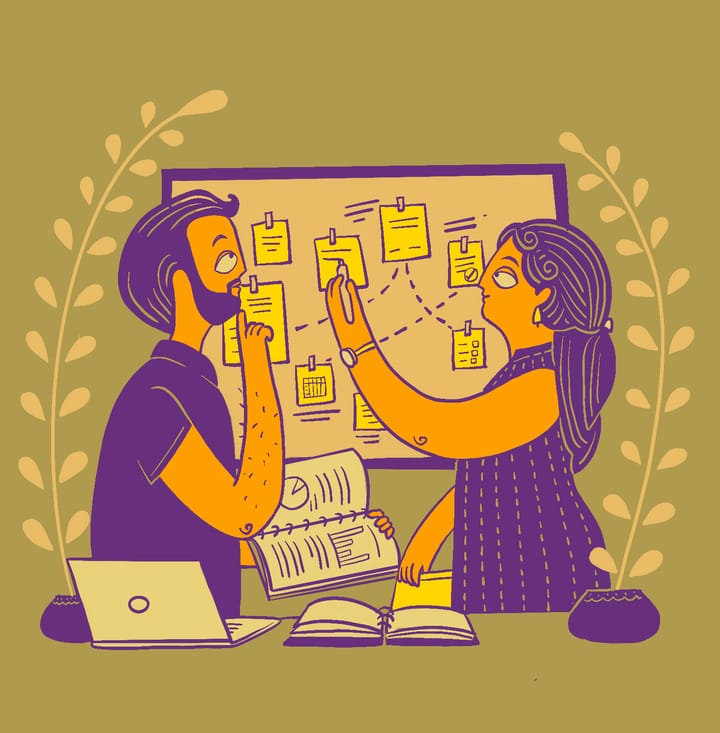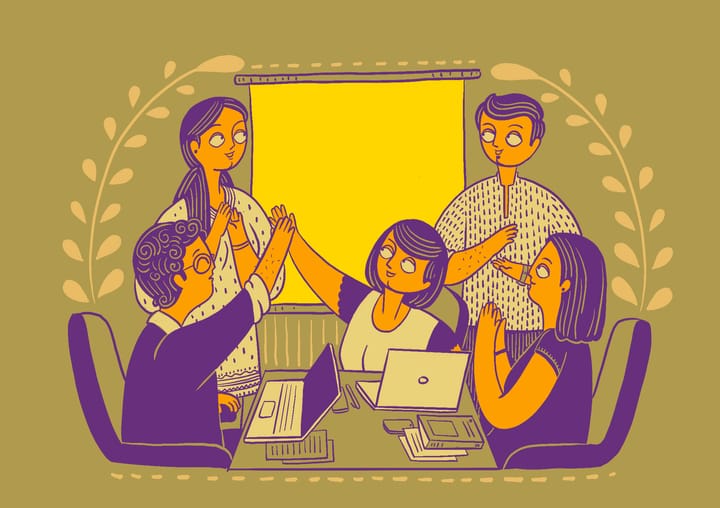A Leaders’ Guide to Preventing Groupthink and Cultivating a Diversity of Opinions
Groupthink differs from group culture and results in suppressed opinions, poor decisions, and a lack of innovation. Learn how to combat groupthink as a leader.

As a leader, it can be great to have the full agreement and acquiescence of everyone on the team. But are people agreeing to your ideas because they see merit in it…or just because of you’re the boss? The fact is that if you want to lead an imaginative and creative team, you must know how to avoid groupthink.
According to Psychology Today, individuals swayed by groupthink deliberately seek assimilation with the ruling majority's agreement. Upon first glance, this may appear to be a good idea. After all, isn't a group's purpose of collaboratively generating ideas to accomplish a greater goal? Not if uniformity takes precedence over sound judgment. And only deliberate, continual thought can yield great quality ideas.
Occasionally, team members who experience social anxiety are more prone to groupthink. However, in some circumstances, this might result from a toxic boss who actively discourages dissent. This style of leadership surrounds itself with flexible individuals while dismissing team members with strong opinions.
What Is Groupthink?
Irving L. Janis, a social psychologist, coined the term ‘groupthink’ in 1972. It is a psychological phenomenon where people strive for group consensus. In several cases, people set aside their personal beliefs favouring the group's consensus.
People who disagree with the group's decisions or overarching viewpoint often remain silent, preferring to keep the peace rather than impede the crowd's uniformity. The phenomenon can be problematic, but even well-principled people can make irrational decisions when faced with tremendous group pressure.

The Influence of Groupthink
It's natural to fall into groupthink behaviours, even more so while focusing on developing a cohesive company culture. It is vital to recognise the tell-tale signs of condescending group agreement and take proactive steps to change the status quo.
Groupthink can lead to people ignoring critical facts and, as a result, making poor decisions. This can be harmful even in minor instances, but it can have far more serious implications in certain circumstances. When the consequences of groupthink hamper medical, military, or political decisions, they can result in unfavourable outcomes.
This phenomenon may come at a heavy price. These are some of them:
- Individual opinions and innovative thoughts can be suppressed, resulting in ineffective problem-solving.
- It may encourage self-censorship among group members. This need for consensus over all else can lead to group members failing to appropriately consider the risks and advantages of an action or decision.
- Additionally, groupthink convinces group members that the group is intrinsically virtuous or right. Stereotypical attitudes toward other groups can lead to this distorted sense of rightness.
While groupthink and conformity are related concepts, there are significant contrasts between the two. Conformity is how individuals alter their behaviour to fit into a certain group. Conformity can lead to groupthink, but it isn't always the driving force behind it.
Also read: Improving Internal Communication at Workplace
Groupthink Pitfalls to Avoid

While groupthink can lead to an agreement, it is a negative phenomenon that leads to inaccurate or erroneous thinking and decision-making. The following are some of the issues it can cause:
- Ignorance of the possibility of undesirable consequences
- Inability to listen to those who hold divergent views
- Lack of imagination
- Inadequate planning to deal with adverse consequences
- Ignoring critical facts and failing to perceive other solutions
- Not looking for information that the organization may not be aware of
- Unquestionable obedience to authority
- Decision-making arrogance
- Resistance to new knowledge or ideas
Consensus-based decision-making enables organizations to make decisions, accomplish tasks, and complete projects swiftly and efficiently—but even the most harmonic groups can benefit from some obstacles. Identifying strategies for avoiding groupthink can help improve decision-making and maintain amicable relationships within the group.
Also read: How to Prevent Work Disagreements from Turning into Conflicts
How to Prevent Groupthink and Combat It
Groupthink can be harmful, leading to poor or even disastrous decisions. It can be avoided by understanding what it is, recognising the symptoms, and taking proactive measures. Here are steps you can follow:
- Raise public awareness: The first step toward prevention is for individuals to understand what groupthink is and how and why it happens.
- Participate in open debates: Create a culture in which people are encouraged to assess events critically, exchange information proactively, and provide feedback.
- Never shoot the messenger: Avoid insulting anyone who expresses opposing views as part of the process of engaging in open dialogues. Demonstrate how to listen critically.
- Record decisions: Once a choice has been made, have team members document the following facts briefly:
- The existing situation and its complications
- A list of all possible solutions and a breakdown of each one
- The suggested solution and why it was selected
- An overarching implementation strategy, timeframe, and budget

The Art of Avoiding Groupthink as a Leader
- Abstain from executing low-quality ideas on a large scale: Before being confirmed, all final judgments should be validated to ensure the quality of the end result.
- Encourage the exchange of ideas: The more members in a group, the more people feel comfortable delegating decisions to the typical decision-makers and keeping their opinions and ideas to themselves. To mitigate such a situation, foster a culture of sharing ideas in the workplace. Teammates should be encouraged to speak up so that they can contribute in a variety of ways to the discussion.
- Reduce the time it takes to make a decision: "Group consensus" considers the process of acquiring unfiltered information and possibly navigating through certain issues to reach a final decision and save time.
- When it comes to hiring, seek people with a variety of personalities: When hiring, try to incorporate people from a variety of backgrounds, ages, and educational levels.
Diversity will bring a variety of viewpoints to the table, resulting in more comprehensive decision-making. With a diverse collection of people on board, the organisation's reliance on teamwork is reduced, and brainstorming is encouraged to develop a diversity of ideas while respectfully challenging one another.
- Attending deliberation meetings isn't necessary: As a leader, body language has the power to convey thoughts on specific topics. A leader's "tells" significantly impact the meeting's diversity of viewpoints. Skip the meeting and delegate decision-making to the team.
- Separate groups into teams: When many people are divided into small groups, a positive group dynamic emerges, promoting creativity in general and ensuring that no one is left out.
- Obtain external feedback: If any aspects of the discussion topic intersect with areas outside the group's competence, don't be afraid to seek advice from persons outside the group who are knowledgeable about the subject.

It's also a good idea to include people from other departments, customers, and other stakeholders who may be affected directly by the decision.
- Assign someone to be the devil's advocate: Assigning a ‘devil’s advocate’ is one of the finest strategies to prevent groupthink and spice things up. This team member's job is to counter any popular suggestions and ideas. Their primary goal is to promote discussion. Any concept that comes from within the group will be put to the test by this type of deliberate opposition.
These techniques, hopefully, will help you combat groupthink and enhance decision-making processes at your organisation.
These are particularly critical for team leaders, given their disproportionate influence. However, everyone on the team should be aware of this phenomenon, know how to avoid groupthink, be able to identify it and assist their teammates in overcoming it.
With an increasing number of teams utilising online meetings and remote work, this presents an opportunity to build processes and tools that aid decision-making rather than hinder it. Utilise communication systems that support many channels, such as video conferencing and screen sharing, and discover ways to engage the team's more reserved members in dialogues. It will contribute to developing a more cohesive team dynamic and eventually benefit the firm.
Final Thoughts
To build upon the poet John Donne’s words, “No one is an island in the modern workplace.” Collaboration is both a fact and a necessity if a company wants to stay in business. When group culture devolves into groupthink, however, adaptability becomes obsolete. The bottom line is that groupthink results in a lack of innovation that only deep, deliberate talks can address.
At Manah Wellness, we provide innovative tools and professional support to dynamic startups, emerging businesses, and trusted brands. Browse our vast range of services and resources to support wellbeing and growth:
Wellbeing Ambassador Training Programme for Corporates
Wellbeing challenges for high-performance teams
Virtual onboarding best practices for 2022
Employee motivation strategies to maintain team morale



